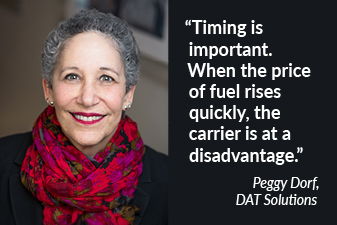|
By Peggy Dorf, DAT Solutions
The price of on-highway diesel is nearly 25% higher today than it was a year ago, and is up an average of 25 cents since the start of the year.
To recoup these costs, carriers use the tried-and-true fuel surcharge, invented in the 1970s when an oil embargo by Arab countries caused shortages and skyrocketing prices at the pump.
Carriers needed protection against fluctuating prices but at that time their rates were regulated by the government. So they added a surcharge to the freight bill based on the price of diesel at the time of pickup or delivery.
The fuel surcharge is a pretty straightforward calculation when applied to the line-haul rate in a six- or 12-month contract.
However, spot market (non-contract) rates are typically quoted for a single job; there's no need to adjust the rate every time there's a change in the price of diesel. That's why freight brokers typically do not break out the fuel surcharge from the total rate in the carrier's rate agreement. Spot rates are "all-in" rates—a line-haul portion plus an extra amount to compensate for fuel.
It's useful to know how to deduct an average fuel surcharge from the spot rate for purposes of analysis. For example, if you want a side-by-side comparison of spot rates and contract rates, you want to focus on the line-haul component only, on an apples-to-apples basis.
Here's one way to calculate the fuel surcharge portion of a spot truckload rate:
Start with a baseline fuel price, or peg. A common standard is $1.25 per gallon, probably based on the price of fuel in the 1980s. The other part of the calculation is the current national average diesel price from the U.S. Energy Information Administration. It changes weekly. In mid-June, the price was $3.24 per gallon.
Subtract the "peg" from the current fuel price and divide by the average fuel economy for a big rig. Mileage will vary, as they say, but as a rule of thumb let's say van-haulers are at 6.0 mpg, reefers at 5.5 mpg, and flatbeds at 5.0 mpg.
|

Now calculate the fuel surcharge with this formula: current diesel price minus $1.25, divided by the mileage estimate. The results?
• Van surcharge =
($3.24 - $1.25) / 6.0 = 33 cents per mile
• Reefer surcharge =
($3.24 - $1.25) / 5.5 = 36 cents per mile
• Flatbed surcharge =
($3.24 - $1.25) / 5.0 = 40 cents per mile
When carriers achieve good fuel efficiency, the fuel surcharge can cover the entire cost of fuel, including the $1.25 baseline.
Timing is important. When the price of fuel rises quickly, the carrier is at a disadvantage. The surcharge in the rate agreement or freight bill is based on today's fuel price, but the carrier typically does not get paid for another 30 days. By then, it costs more to refill the tank.
That's one reason why trucking companies, especially the smallest fleets, have a hard time when fuel prices jump unpredictably. A quick-pay program is likely to be popular with carriers when fuel is expensive, as it helps to resolve their cash flow issues.
While carriers can factor in fuel costs when they negotiate their line-haul rates, surcharges tend to have a more dramatic and immediate effect on the bottom line of the freight bill. You may not be able to control the price of fuel, but you can learn more about how it's calculated—even in an "all-in" spot rate.
Peggy Dorf is a market analyst with DAT Solutions, which operates the DAT® network of load boards and RateView rate analysis database and tools. She researches and writes about the impact of economic trends on companies and individuals in transportation and logistics. Peggy is based in Portland, Ore.
|


